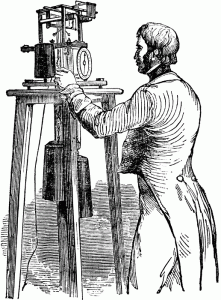
This is NOT an "Information Revolution"!
Our readers often tell us they want to know how to improve their skills in technological design. Hopefully you’re interested in this as well. Maybe you stay honed by reading technology blogs and Twitter, and perhaps you occasionally get swept up by the hype of marketing gurus who claim we’re part of a new revolution. The problem is, the real information revolution was over a century ago! Of course it’s important to keep up-to-date, but let me tell you why it’s equally important to clean the dust off some old books and start learning design from history.
We can’t afford to believe the hype.
If you spend a lot of time on the web, you probably believe that we are on the cusp of some kind of “information revolution”. If this is something that motivates you to push further, don’t let me steal that from you – certainly the latest in sleek, smooth and functional technology which participate in a global network is remarkable and unprecedented. However, if you’re a critical thinker, you have the potential to see beyond the hype! When you engage in major projects, you have a responsibility to make the right judgements by learning from the history of media.
Designers who dip into the interdisciplinary depths of human knowledge are an endangered species, mostly due to hype: do you really think computer technology is a fundamental game-changer in the context of human progress? I’m often surprised at how many simply assume this to be the case without thinking about it themselves. It is in response to this fallacy that I wanted to remind our readers that the notion of an “information revolution” is simply not ours to claim. Nowhere is this more important to consider than in our fields of research and design. Believing our generation’s selfish hype causes narrow vision, a serious obstacle to drawing upon the diverse sources necessary for good interaction design.
 When was the REAL “information revolution”?
When was the REAL “information revolution”?
In a quick read called “The Victorian Internet“, Tom Standage draws extensive comparison between today’s Internet and the 19th century telegraph. Many attributes of today’s so-called “information revolution” actually surfaced in the mid-19th century. While the Internet gets the credit, the telegraph was the true breeding ground for instant messaging, e-mail, piracy, use of abbreviated language, and more. However, all of these developments pale in comparison to the telegraph’s biggest contribution: the increased scope of news media.
In the mid-19th century, the average person’s daily reading transitioned from local, month-old news in a small community to global events from the previous day. In a world where reporters traditionally took their time piecing together stories from past months, the telegraph built a competitive news industry by communicating daily news and events around the world in minutes. This development was arguably the seed for our globalized media environment. The people of this time period saw a much more profound change than us: a true information revolution.
Designers: embrace the history of new media.
The telegraph exemplifies why people working in technology would be smart to avoid focusing only on the work of our generation. While today’s technological design concepts certainly have merit, one should not ignore the historical progression of media. Important lessons and inspiration lie in traditional approaches to literature, painting, music, architecture and more.
- Consider the Rosetta Stone, an artifact which contained an identical message in Greek and Ancient Egyptian. This stone served as a key, allowing us to use our knowledge of Greek to interpret and decipher the Ancient Egyptian language. Similarly, mapping complex technical terminology to recognizable words and metaphors helps facilitate the learnability of complex interfaces.
- As another example, recent work by Steve Dipaola studying the art of Rembrandt has shown that this master painter was using techniques which manipulated the audience’s experience of the work. Whether intentional or not, Rembrandt was painting for the user experience in the 17th century.
- Finally, consider the advent of functionalism in early 20th century architecture. This movement, captured famously by Louis Sullivan’s “form ever follows function”, directly connects to today’s doctrine in user interface design.
In a few examples, you can see that we are not in some completely new field. Instead, our work fits neatly with historical precedents, suggesting that we would be foolish not to draw upon the work of our ancestors for inspiration. This is why I firmly believe that people who work in technology should embrace older ideas and techniques. By all means, keep following blogs and Twitter, but don’t forget to pick up some inspiration from your media ancestors.
Working in web? Learn about the printing press. Designing graphics and visuals? Learn about painting and portraiture. Working in physical ergonomics? Take classes in sculpture. Specializing in information architecture? Learn about the history of language. You will be surprised how useful a foundational approach can be in providing progressive and impressive research methods and design solutions for your clients.
1 Comment(s)
Wasm’t it Bill Gates who said: “Evolution, not Revolution…” ? 🙂